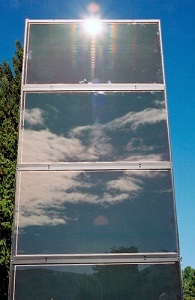New data shows second-by-second impact of clouds on large photovoltaic arrays
 Last week, the National Renewable Energy Laboratory (NREL) released detailed data about how clouds affect large photovoltaic plants, up to about 30 megawatts in size. The lab measured the impact of clouds with 17 sensor stations that collected data at 1 second intervals—for an entire year. That’s 31.6 million seconds worth of data points collected at 17 locations.
Last week, the National Renewable Energy Laboratory (NREL) released detailed data about how clouds affect large photovoltaic plants, up to about 30 megawatts in size. The lab measured the impact of clouds with 17 sensor stations that collected data at 1 second intervals—for an entire year. That’s 31.6 million seconds worth of data points collected at 17 locations.
The information, which is now available at NREL’s Measurement and Instrumentation Data Center (MIDC), will help utilities, solar developers, system operators, forecasters, labs and universities better understand how clouds impact large-scale solar plants.
What the study found is that large-scale photovoltaic installations are impacted by cloudiness, but the shifts are not as dramatic or as quick as with a smaller system, like a 1 megawatt system.
“The key here is being able to adequately verify what that variability would be, and we didn’t really have the data until this data,” said Ben Kroposki, an NREL principal engineer and a leader of the project. “The larger the plant, the less variability because of clouds.”
Production on a 1-megawatt plant can go up or down very quickly since photovoltaics respond so rapidly to changes in light.
“It can change in seconds to tens of seconds. With a 30-megawatt plant, it won’t change that rapidly,” he said.
Also, smaller clouds don’t affect the whole systems as much, according to Kroposki.
“From a power system perspective,” he said, “you don’t see the fluctuation [as much].”
The data could be used to extrapolate the impact on larger systems, but it wouldn’t be verified at this point, Kroposki said.
“We have another [study] we’re doing in Florida right now. We’re building irradiance sensors to look at plant 300 megawatts in size,” he said.
A Hawaiian study, which was conducted without an actual solar installation in place, reflected the largest proposed photovoltaic system for the islands at the time.
“This was not done at a place where there was currently an installation. Right now we have just the irradiance data. One of the big pushes in Florida was to have the irradiance data with an actual plant. But we get good irradiance data even with just the sensors,” Kroposki said.
The data from Hawaii can also be used to predict the impact of clouds on solar in Florida, since it has a similar climate, and elsewhere.
But NREL also is working with the installers of large-scale photovoltaic arrays in the desert Southwest to study the impact of clouds on solar in those locations, he said.
Image courtesy of NREL.



